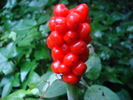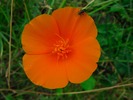
|
Chart of flowering plant families: Interpretation |

|
Home |
View chart |
Guide |
Index |
Availability |
Links and contacts |
How to interpret the chartThe chart depicts a recently developed phylogeny of all existing flowering plants. The disks represent families of plants. Groups of related families are indicated by a hierarchy of regions and some of these groups are named. For more than 250 years, families of flowering plants and relationships between families were determined mainly by morphology (the structure, shape and number of plant parts). Since the 1990s, genetic information has become available and now the affinity of species, genera and families is determined primarily by this molecular evidence. The previous morphological classifications were, to some extent, supported by the molecular analysis. However, major changes have been necessary both to the circumscription of some families and to the placement of families relative to each other and to the corresponding higher groupings. The chart is based on extensive recent work aimed at resolving the molecular phylogeny of flowering plants (summarised in [1], documented in [2], [3] is a dictionary of plants based on a molecular classification). The chart depicts a phylogenetic tree in terms of a hierarchical grouping of families. Many of these placements are now well-established, but uncertainties remain - these we have tried to indicate on the chart (see below for details of how uncertain placements are depicted). The chart will be updated as new results become available. |
Phylogenetic treesThe chart corresponds to a phylogenetic tree. Regions on the chart, delimited by boundaries or shaded areas, correspond to nodes in a tree, and families, as disks on the chart, are leaves of the tree. In trees, proximity of two families is represented by the depth of the root of the smallest subtree containing the two families. Here it is represented by a shared region. Proximity does not cross boundaries: families close on the chart but separated by a boundary are no closer than their common region indicates. Boundaries are depicted with varying styles and colours - this is merely to aid the eye and has no phylogenetic significance. UncertaintiesMany of the placements of families are now well-established and much work has been done to resolve remaining issues. However, uncertainties remain. The chart is not intended to be a resolution of these. Where evidence is poor, we have either (a) left relationships unresolved (as a `polytomy'), or (b) chosen the best supported on current evidence, or (c) indicated alternative placements. On the whole, we have been conservative in the depiction of family relationships. As new evidence appears, new versions of the chart will be published. An estimated age for some taxa is indicated. We have included this information only when it is clearly supported by fossil pollen evidence, but even these estimates should be viewed with caution. NomenclatureA classification would normally allocate names to groups in a hierarchy in a systematic way. Following standard practice, we have not done this exhaustively. Instead, we name only those groups where a name has proved useful, e.g. Monocots, Asterids, etc. and names of orders (suffix -ALES, mainly coloured grey on the chart). Common names: Common or vernacular names are used to describe some familiar plants and products. These names vary from language to language. This is particularly a problem when only local names are available. In addition, the same common name may be used for several (sometimes unrelated) species. Occasionally, these ambiguous names have been used but accompanied by the relevant genus. In all, common names on the chart should be treated with caution. An Index of Flowering Plants is available to accompany the chart. This provides a more comprehensive list of flowering plants and their products, their location on the chart, and details of the use of common names. DistributionThe predominance of the tropics in flowering plant diversity is evident. Indeed, the richness of tropical forests is astonishing. For example, in parts of the Amazon forest, an area as small as c100 km2 may contain more than 1,000 species of trees.(*) On the chart, the role of certain areas amongst whose endemics are species of high significance in phylogeny is clear. Such areas are concentrated in the tropics and subtropics, but also include isolated Gondwanaland fragments and areas of high diversity in the Northern temperate zone.
-------------- Chart detailsThe chart is designed to be viewed at A1 size (594 x 841mm, 23.4 x 33.1in) or larger. If viewing in PDF, you may change the magnification in order to view and navigate the chart. Personal noteThe chart was prepared with the personal objective of creating an attractive visual aid and, to some extent, an informative display for my own use. Early versions were prepared before the advent of molecular systematics and used a morphological classification based on that of Cronquist [5] and a display inspired by that of Stebbins [6] extended to the family level. With the development of molecular phylogenies, considerable redesign of the chart was required, including now much 'fine-structure' in the relationship of families. I have decided to make the current version generally available. I hope that it is found as useful and as attractive as I intended. It will be updated as new results become available. Printed versions of this chart (A1 size) are also available. A similar chart of fern families is available. Other charts of plant families are in preparation. David Rydeheard (2011) References
|
|
The chart is designed by David Rydeheard, who owns the copyright. It should not be distributed in any form other than that available on this website and must always include the copyright notice. It is available for personal use or for teaching and research purposes only. Please contact the author (at BotanicalChart@gmail.com) for permission to use in commerce or for personal gain. |